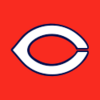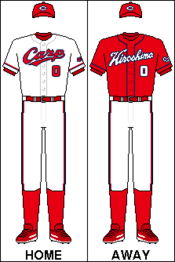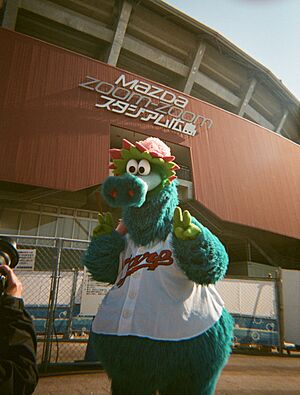Hiroshima Toyo Carp facts for kids
The Hiroshima Toyo Carp (広島東洋カープ) is a professional baseball team from Hiroshima, Japan. They play in the Central League of Nippon Professional Baseball. The Matsuda family owns most of the team, and the car company Mazda is also a big shareholder. The team's name, "Toyo," comes from Mazda's old company name, Toyo Kogyo.
The Carp are special because they are one of the few professional baseball teams in Asia that are mostly owned by a private family, not a big company. The team was started just four years after the atomic bombing of Hiroshima. Because of this, the Carp are often seen as a symbol of Hiroshima's recovery after the war.
Currently, the Carp have the longest wait for a Japan Series championship. They are the only team that has not won the series in the 21st century.
Quick facts for kids Hiroshima Toyo Carp |
|||||
|---|---|---|---|---|---|
| 広島東洋カープ | |||||
|
|||||
| Information | |||||
| League | Nippon Professional Baseball
|
||||
| Location | Minami-ku, Hiroshima, Hiroshima, Japan | ||||
| Ballpark | Mazda Zoom-Zoom Stadium Hiroshima | ||||
| Year founded | December 5, 1949 | ||||
| Nickname(s) | Koi (鯉, carp) | ||||
| CL pennants | 9 (1975, 1979, 1980, 1984, 1986, 1991, 2016, 2017, 2018) | ||||
| Japan Series championships | 3 (1979, 1980, 1984) | ||||
| Former name(s) |
|
||||
| Former ballparks |
|
||||
| Colors | Red, White, Navy |
||||
| Mascot | Slyly | ||||
| Playoff berths | 6 (2013, 2014, 2016, 2017, 2018, 2023) | ||||
| Retired numbers | 3, 8, 15 | ||||
| Ownership | Hajime Matsuda | ||||
| Management | Matsuda family | ||||
| Manager | Takahiro Arai | ||||
| Uniforms | |||||
|
|
|||||
Contents
Team History
Starting the Team
In 1949, the Nippon Professional Baseball league decided to split into two groups. Hiroshima wanted to create a baseball team to help rebuild the city after the atomic bombing. The team joined the Central League in December 1949 and was called the Hiroshima Carp.
The name "Carp" came from the koi fish that swim up the rapids of Hiroshima Castle. This name was chosen to show Hiroshima's rebirth and its strength in tough times. A politician named Noboru Tanigawa suggested the name.
Early Challenges
The team's first home field was a stadium paid for by the prefecture. The Carp had very little money, which made it hard to find good players. The manager, Hideichi Ishimoto, even had to look for players himself. The team finished in last place in 1950 and 1951.
In 1951, the team's money problems got worse. The league suggested that the Carp should close down or join another team. But the people of Hiroshima strongly protested. They raised money through donations to keep their team playing.
In 1952, the Central League had seven teams, which made scheduling games difficult. So, they decided that any team ending the season with a winning percentage below .300 would be disbanded. This rule might have been aimed at the Carp. However, the team won 37 games that year, thanks to their star pitcher Ryōhei Hasegawa. They ended with a .316 winning percentage, which saved them. Another team, the Shochiku Robins, was merged with the Taiyo Whales instead. The Carp then signed many of the Robins' best players.
Money was still tight in the following years. In 1953, players only got one uniform each! But the team kept playing. In July 1957, they moved to the new Hiroshima Municipal Stadium. Finally, in 1960, they finished a season with more wins than losses.
In 1968, the Toyo Kogyo company became the team's main sponsor. The team's name changed to Hiroshima Toyo Carp. The company later became Mazda Motor Corporation in 1984, but the team kept the "Toyo" name to remember their history. The Carp finished above 3rd place for the first time in 1968.
The "Red Helmet" Golden Age
In 1973, red became the team's new main color, and their uniforms were redesigned. The team's logo also changed from an "H" to a red "C," similar to the Cincinnati Reds logo.
In 1975, the Carp hired their first non-Japanese manager, Joe Lutz. He wanted the team's caps to be red to show a strong fighting spirit. Lutz left the team early in the season, but his replacement, Takeshi Koba, led the Carp to win their first-ever league championship in 1975! They played in the Japan Series but lost to the Hankyu Braves.
The Carp became a very strong team in 1978. They hit over 200 home runs in one season, which was a first in Japanese baseball history. Players like Koji Yamamoto, Sachio Kinugasa, Jim Lyttle, and Adrian Garrett formed a powerful group known as Akaheru (meaning "Red Helmet"). This team won two league championships and two Japan Series in a row in 1979 and 1980. They were the last Central League team to win back-to-back Japan Series until 2023.
A strong group of pitchers helped the Carp win another Japan Series in 1984. Manager Koba retired in 1985, but the team still won the league championship the next year. In 1987, Sachio Kinugasa broke Lou Gehrig's record for most consecutive games played.
Star player Koji Yamamoto became the manager in 1989, and the team won another league championship in 1991. However, the team fell to last place in 1993, and Yamamoto stepped down.
Tough Years
After their 1991 championship, the Carp went through a long period without much success.
One big reason for this was that the team didn't get much money from its sponsors. They rarely signed free agents and often had to let go of their best players because they couldn't afford their salaries.
In 2006, Marty Brown became the manager, the first non-Japanese manager in 31 years. The team focused on developing young players. In 2008, even though many expected them to finish last, they almost made it to the playoffs, finishing fourth.
Since 2009, the team's home stadium has been the Mazda Zoom-Zoom Stadium Hiroshima.
Recent Success and Revival
After many difficult years, the Carp finally found success again in 2016. They had the best record in the league and beat the Yokohama DeNA BayStars to reach their first Japan Series since 1991. They won the first two games but lost the next four to the Hokkaido Nippon-Ham Fighters. After that season, pitcher Hiroki Kuroda, who had returned to the Carp in 2015, retired.
The Carp again finished with the best record in the Central League in 2017. However, they were surprisingly defeated by the BayStars in the playoffs.
In 2018, the Carp won another Central League championship and swept the Yomiuri Giants in the playoffs. But they lost the Japan Series again, this time to the Fukuoka SoftBank Hawks.
In 2019, the Carp finished fourth, just missing the playoffs. This ended their streak of three straight league championships. They also missed the playoffs in 2020, 2021, and 2022.
In 2022, the Carp lost star player Seiya Suzuki to Major League Baseball. Despite this, they started the season well but still missed the playoffs.
In 2023, the Carp were expected to finish last, but they surprised everyone by finishing second in the league! They beat the DeNA BayStars in the first round of the playoffs but then lost to the Hanshin Tigers in the final round, missing the Japan Series.
In 2023, on June 7, pitcher Daichi Ohsera achieved a no-hitter against the Chiba Lotte Marines. This was a rare and exciting event in baseball.
Team Uniforms
The uniforms of the Hiroshima Toyo Carp look similar to those of the Major League Baseball team, the Cincinnati Reds. The Carp's original uniforms were inspired by the University of Chicago's baseball team, which visited Japan in 1912. That team played against Chuo University, whose players copied the uniforms, including the "C" logo. Alumni from Chuo University later helped start the Hiroshima Carp.
Team Mascots
- One of the team's mascots is "Carp Boy" (カープ坊や Kāpu Bōya), who is seen in the team's logo.
- Their other mascot is "Slyly" (スラィリー Surairī), who looks a lot like the Phillie Phanatic from the Philadelphia Phillies. Both Slyly and the Phillie Phanatic were designed by the same company, Harrison/Erickson. Slyly has been with the team since 1995.
- From 2005 to 2007, the team had the first Japanese baseball dog named "Mickey" (ミッキー Mikkī). Mickey was a Golden Retriever who wore jersey number 111. He would bring new baseballs to the umpire from the dugout during games. Mickey passed away in 2009.
- Until 2015, Hiroshima Municipal Stadium was closed every year on August 6 to remember the atomic bombings. The team would play in other stadiums on that day. In 2015, the Carp played their first August 6 home game at Mazda Zoom-Zoom Stadium. All players wore uniform number 86 (for August 6) and "PEACE" on their jerseys to symbolize the city's wish for world peace.
Unique Cheering Styles
Squat Cheering
The Hiroshima Toyo Carp fans have a special way of cheering called "Squat Cheering." While other teams often repeat song lyrics, Carp fans sing the lyrics once and then shout the player's name.
When a player is up to bat, fans sing the song. Then, they divide into two groups. One group stands up and shouts the player's name, then sits down. The other group does the same. They repeat this standing and sitting motion several times, which is why it's called "Squat Cheer." This cheering style became popular around 1993.
Three Call
Before a cheering song, Japanese baseball fans often do "three calls." A common example is "Kattobase Kattobase ○○" repeated three times, followed by "Kattobase-○○." ("Kattobase" means "hit the ball hard.")
For the Carp, they also have a "motte koi" call: "motte koi motte koi○○" repeated three times. After repeating it, they shout "Motte Koi!" ("Mottekoi" means "please hit a home run into the stands.") They use a similar call for home runs.
Chance Theme
In Japanese baseball, teams have a special cheering song called a "Chance Theme." This song is usually played when the bases are loaded, meaning there's a good chance for the team to score many runs.
Carp Baseball Academies
The Carp were the first Japanese baseball team to start a baseball academy outside of Japan. Because they didn't have a lot of money to sign famous non-Japanese players, they created academies to find and train young players cheaply.
The Carp Baseball Academy opened in the Dominican Republic in 1990. Robinson Checo was the first player from this academy to play in Japan in 1995. Other players who later played in Major League Baseball, like Timo Pérez and Alfonso Soriano, also came from this academy.
In 2004, the Carp also started a pitching academy in Guangdong, China. This was part of their effort to help baseball grow in Asia.
Notable Players
Players Who Played in MLB
- Kenta Maeda (2016–)
- Seiya Suzuki (2022–)
- Ryan Brasier (2013, 2018–)
- Colby Lewis (2002–2004, 2006–2007, 2010–2012, 2014–2016)
- Hiroki Kuroda (2008–2014)
- Ken Takahashi (2009)
- Richie Scheinblum (1975–1976)
- Alfonso Soriano (1999–2014)
Retired Numbers
These numbers are so special that no other player on the team will ever wear them again.
- 3 – Sachio Kinugasa (played from 1975–1987)
- 8 – Koji Yamamoto (played from 1971–1986)
- 15 – Hiroki Kuroda (played from 1997–2007, 2015–2016)
Honored Numbers
These numbers are important to the team's history and are often given to new star players.
- 1 – Tomonori Maeda (1994–2013), Seiya Suzuki (2019–2021)
- 7 – Kenjiro Nomura (1989–2005), Shota Dobayashi (2013–)
- 18 – Shinji Sasaoka (1990-2007), Kenta Maeda (2008–2015), Masato Morishita (2020–)
- 20 – Manabu Kitabeppu (1976–1994), Katsuhiro Nagakawa (2003–2019), Ryoji Kuribayashi (2021–)
- 25 – Takahiro Arai (1999–2007, 2016–2018, 2023–)
Team Managers
| Name | Nationality | Period |
|---|---|---|
| Shuichi Ishimoto | 1950–1953 | |
| Katsumi Shiraishi | 1953–1960, 1963–1965 | |
| Masato Monzen | 1961–1962 | |
| Ryohei Hasegawa | 1965–1967 | |
| Rikuo Nemoto | 1968–1972 | |
| Katsuya Morinaga | 1972, 1974–1975 | |
| Joe Lutz | 1975 | |
| Takeshi Koba | 1975–1985 | |
| Junro Anan | 1986–1988 | |
| Koji Yamamoto | 1989–1993, 2001–2005 | |
| Toshiyuki Mimura | 1994–1998 | |
| Mitsuo Tatsukawa | 1999–2000 | |
| Marty Leo Brown | 2006–2009 | |
| Kenjiro Nomura | 2010–2014 | |
| Koichi Ogata | 2015–2019 | |
| Shinji Sasaoka | 2020–2022 | |
| Takahiro Arai | 2023– |
Farm Team
The Carp also have a "farm team" (a team for developing younger players) in the Western League, also called Toyo Carp.
Their ballpark, Yuu Baseball Ground, is located about 20 kilometers (12 miles) southwest of Iwakuni in Yū, Yamaguchi. It was built in 1993 and has a main field with seating for 3,500 people, plus a smaller practice field.
See also
 In Spanish: Hiroshima Toyo Carp para niños
In Spanish: Hiroshima Toyo Carp para niños







